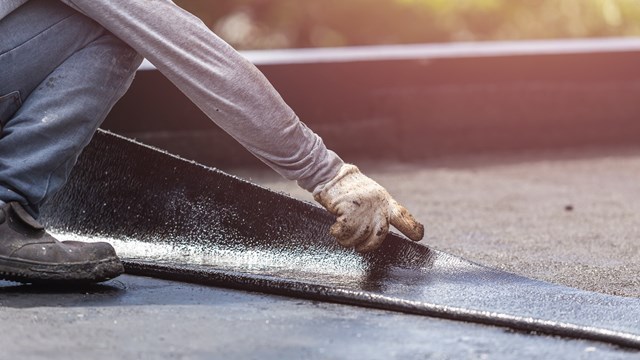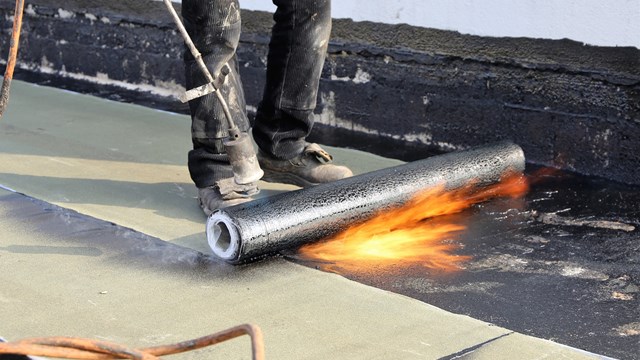In the legendary musical
It's a challenge, however, that shouldn't be ignored. Keeping your building's exterior clean is not just about aesthetics, but it's about creating a positive atmosphere for residents. A clean building is also a more attractive financial investment and more viable in the real estate market; good exterior grooming shows the building is being maintained. Ignoring a lingering patina of grime can also cause damaging pollutants such as sulfur, nitrogen oxides, and other acid rain pollutants to break down and deteriorate the building's surface material.
However, it's a challenge that should be left to the professionals, not the building cleaning staff. Cleaning a building isn't just about using any soap and a power washer. Cleaning professionals are knowledgeable about various building materials including limestone, brownstone, marble, metal and brick, and will thoroughly evaluate your façade to determine what various substances and approaches are needed to clean and protect that material.
"You only hope someone hasn't tried to clean the surface before you get there," says Ed Talmo, president of Enviro-Northeast, an exterior maintenance firm in Highland Lakes, New Jersey. "They mean well, but they don't have the background and the knowledge about the specific type of stone or brick it is, whether the surface has been painted or sealed, and what type of cleaners can be used on it. The worst case scenario is when you go to the job and find acid burns [on the building] because people don't know what they are doing."
A thorough cleaning of an especially dirty building façade should be done every two to five years, unless something particularly nasty is on the surface that needs to be taken care of right away. "Otherwise, ignoring whatever is on the [exterior] can start breaking the surface down and causing problems," says Talmo. "Once a year might be a little excessive, and some buildings can get away without a cleaning for five or 10 years where the pollution isn't that bad."
In New York City, it's hard to find an area where the buildings aren't hard hit with dirt and pollution. "Buildings that are close to or along the highways, those on main streets with bus traffic, and buildings close by airports are going to get it worse," says Talmo.
According to Mark Roth, vice president of Clark & Wilkins, a cleaning company in Manhattan, rarely are cleaning crews hired just to do a building façade cleaning. "Usually it's one part of a façade restoration," says Roth. "If they are fixing bricks or other building parts they are already putting rigs on the building, so that's when you want to do the thorough cleaning."
Even a thorough cleaning doesn't have to be a huge undertaking. Many building managers opt to clean from the ground floor to the fifth or sixth floor; a more affordable option, since this is the only area that is closely visible to passers-by.
Your contractor should be experienced in cleaning building façades, and should come to the building for an evaluation. "We need to see what the material is and bring different products with us to test a corner of the building to see what works best," says Alan Poritz, president of Clean Swift Maintenance in Staten Island. "We want the owner there when we are testing the products, and we rarely tell the customer we'll get the building 100 percent clean. You're not going to get everything off the buildings."
But not every façade requires the same amount of care and attention. Some more (relatively) delicate materials such as limestone and brownstone require special consideration, as do historic buildings and unique architectural ornaments. "Limestone and brownstone are softer, more porous materials, so we slow down the pressure of the washer when we clean it and stay further away from the building," says Poritz.
There are several methods that are used to perform a general cleaning of a building façade. Some methods include high-pressure water blast, chemical cleaning agents, hand scrubbing, or a combination of approaches.
An abrasive cleaning method is a rapid way to remove dirt accumulation, unsightly stains, and deteriorating paint. Abrasive cleaning includes the use of certain materials - most commonly sand - which impact the surface under pressure. Other materials, such as walnut shells, eggshells, glass beads, synthetic particles and even just high-pressure water, can also be used.
However, abrasive cleaning is just that - abrasive - and not only blasts off the dirt and soil, but can also erode the surface being cleaned. For example, it can remove the hard protective surface of brick and make it more vulnerable to deterioration. Abrasive cleaning can also be a detriment to delicate architectural detailing, especially on historic buildings. A dry abrasive cleaning can also create problems with dust, and while a wet abrasive cleaning is dustless, it must be done in warmer weather. If the water freezes in any cracks in the building's exterior, it can expand and cause damage to the interior walls.
Chemical cleaning agents may also be used, including hydrofluoric acid and other acid compounds ranging toward the higher end of the pH scale. "Most of the time we use environmentally safe cleaning products, but sometimes you have to use acid cleaners," says Poritz. "There's a complete range of all different acids, and it's very difficult for someone who is not in the field to go and buy the right product. Even if they buy an acid, they need to know the proper dilution rate - a test sample will provide the contractor with that knowledge."
Contractors also analyze the best time of day to clean buildings, considering people traffic, parking situations, and the inconvenience to residents. The City of New York Department of Environmental Protection (DEP) publishes an advisory for building façade cleanup that explains the city's requirements for such projects, including notifying building occupants, restricting the area, marking it with caution tape, and not undertaking cleanup work when wind speeds are greater than 20 mph. All windows are to be closed during the cleaning and some air conditions and windows may require sealing with duct tape. Contractors also must consider containment requirements, which means that if the building will be washed, the contractor cannot allow contaminated run-off water to drip onto the sidewalk and down the drains.
Fortunately, thanks to an aggressive campaign to rid the city of graffiti vandalism, there has been a decline in the amount of graffiti that needs to be expunged. "People and politicians don't want it, so they are spending money to clean it up and prosecute those individuals who are vandalizing properties," says Poritz.
Last year, Mayor Michael Bloomberg announced progress in the fight against graffiti. Since launching the graffiti cleanup initiative in July 2002, the city's multi-agency Anti-Graffiti Task Force has removed over 16.3 million square feet of graffiti from more than 6,241 sites across New York City. The Department of Housing Preservation and Development (HPD) removed approximately 14,500 square feet of graffiti from 157 properties, and The Human Resource Administration and the New York City Housing Authority also removed thousands of pieces of graffiti from hundreds of sites within their properties.
There are a number of graffiti removal products on the market. Some of the thick markers often used to deface surfaces are not permanent, and it may be possible to just use soap and water. However, while the ongoing argument continues - is it art, or just vandalism? - there is one point of agreement: it can be hard to remove on painted or porous surfaces.
"To remove graffiti on masonry is simple," says Peter Chiappetta of International Graffiti Control in Fairfield, Connecticut. "It's an application of a biodegradable - yet still hazardous - potassium hydroxide gel that you put on as long as it's at least 50 degrees outside. It sits on the surface from 20 to 45 minutes, and is rinsed off with high pressure."
Many times paint on a rough surface causes permanent damage - and the process gets more difficult if the surface is painted. "You have a problem if it's a painted surface," says Chiappetta. "If you remove [the graffiti], you'll probably remove the paint, and repainting one area will probably cause other sections to look different."
According to Poritz, a popular new product on the market is methyl soyate, a soybean-oil-based methyl ester, which is gaining acceptance as an excellent solvent alternative and graffiti remover. "It's a very environmentally safe product that we've been using for a few years," says Poritz. "You can use it inside or outside, and it does a better job cleaning."
Chiappetta explains that the best cure is prevention. Applying a preventative coating (like a waterborne polyethylene) after painting or before any vandalism occurs will help to easily remove the graffiti with warm water, a cleaner made for the preventative coating and a little elbow grease. Once the graffiti is removed, another layer of the preventative coating is reapplied.
The costs of these cleaning jobs vary, but square footage is a common way of pricing. The costs will also depend on the size of the graffiti and of the building, and the products and methods being used. "If we are cleaning up a single tag of graffiti, my minimum used to be $295 for a half hour to 45 minutes," said Chiappetta. "A full day two-man crew can run $1,500 to $2,000 and up."
The pros agree that when hiring a contractor, check their references and visit the buildings that they have cleaned on past jobs. Contact the owners and find out what if any obstacles came up during the process, including permits, scaffolding, and so forth. A little homework and good reference check can help you make sure your blemished building will soon be back to its old self, and with some preventative maintenance, diligence, and professional guidance, your building can radiate a clean, well-cared for atmosphere that Reno would be proud of.







Leave a Comment